#Maya is a 3D animation program for those who don’t know
Explore tagged Tumblr posts
Text
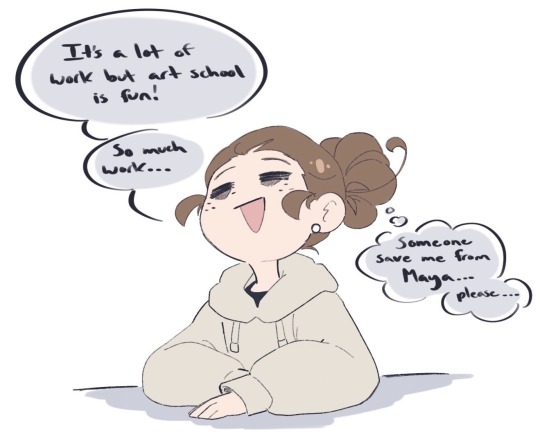
It’s only been a week and I now understand why the application stressed that the program is a full time commitment
Shout out to all the 3D animators out there, I DO NOT want your job
#personal art#I hate Maya and Maya hates me#Maya is a 3D animation program for those who don’t know#give me pencil and paper any day#if you don’t see me post as much fan art as usual it is because I am dying
137 notes
·
View notes
Text
Artist Resources (Part 1?)
This is basically just going to be a bunch of resources I have found to be useful. I can’t say that I’ve used all of them, but I’m sure they��re all worth checking out.
I’m also gonna try to put a detailed description for most of the links so you have a better idea of what you’re getting. I apologize in advance if some of them are redundant lol
(I put “Part 1″ if in the case I make another one)
~Links to Tutorials, Tips, Resources, etc~
Another Resource List -- Leads to another Tumblr post. Apparently, the post isn’t mobile-friendly, so it’s suggested to view this on Tumblr browser. Has a bunch of other links. I’ve checked out a few of them (mainly the copyright stuff lol), and it seems that some of the links may be a bit outdated. Still, it doesn’t hurt to check out the links.
Arms and Legs -- Leads to another Tumblr post. A handy tutorial on elbow and knee placement.
Art & Game Dev -- This leads to my personal playlist of a bunch of YouTube videos. Has a bunch of tutorials and interesting videos that I’ve collected over the course of a few years lol.
Blamblot -- A website that contains resources and tutorials on comic lettering. This is primarily in reference to western comics, but it doesn’t help to take a looksie.
Commission Calculator -- Leads to another Tumblr post. Helps artists to stop selling themselves short.
Comparing Heights (hikaku-sitatter) -- A height comparer for centimeters.
Comparing Heights -- A height comparer for feet and inches.
Mouth Shapes and Lip-Syncing -- Leads to another Tumblr post. Useful for... drawing mouth shapes.
Reference Angle -- Useful for when you’re trying to map out a face from an odd angle.
Soft Proofing for Printing -- Leads to another Tumblr post. Helps when you’re trying to make prints of your artwork.
Textures -- A website full of different and mostly free textures. While this website is made for 3D texturing, it can also be useful for 2D drawings. Signing up gives you 15 free credits everyday, and you can use those credits to download some textures for free.
The Models Resource -- A website of models ripped from a wide array of games.
The Spriters Resource -- A website of sprites ripped from a wide array of games.
The Textures Resource -- A websites of textures ripped from a wide array of games.
~Links to Stock Images~
Please check out whatever policies they may have for their images before using them!
(not sure if any of them are active anymore as I followed some of these accounts a long time ago when I used to be more active on Deviant Art lol)
adorkastock (formerly senshistock)
anatoref -- Leads to another Tumblr post. Has a bunch of hand photo references
charligal-stock
HumanAnatomy4Artist -- Does contain nudity
null-entity
PhelanDavion
RobynRose
~Links to Other Artists~
Akihito Yoshitomi -- Yoshitomi is a mangaka who has tutorials on manga making. He also has an insightful series in which he drafts and draws a 30-page manga in 18 days. Remember that every artist works differently and his process may be different from another’s.
Drawfee -- Drawfee is an improv drawing show of four artists: Nathan Yaffe, Jacob Andrews, Julia Lepetit, and Karina Farek. While they don’t have tutorials in a sense, their videos explain the different processes they go through as they draw. They also occasionally provide tips, tricks, and resources in their videos. They do have another channel and a Twitch channel where they host drawing classes in addition to other fun shenanigans.
EtheringtonBrothers -- Has a bunch of useful and eye-catching tutorials called “How to Think When You Draw”.
Mark Crilley -- Mark is a comic artist, specializing in manga, who has a bunch of tutorials about anatomy, perspective, comic making, and other things.
Miyuli -- Miyuli is an artist who posts tutorials on their Twitter. Their tutorials range from anatomy to clothing to other things. They even have a few books of art tips. Currently (as of the time of posting this), their 2018 version is free for download, so I highly recommend you download that. Some tips may be outdated, but they should still be helpful.
Whyt Manga (Twitter/YouTube) -- Odunze is a comic artist, specializing in manga, that has a bunch of tutorials on manga making and drawing characters of color.
~Links to Free Programs~
Blender -- A free 3D program if you’re into 3D modeling and such. I also personally haven’t used Blender (I use Maya lol), but I know it’s a respectable program.
Krita -- A free painting program if you can’t afford Photoshop or Clip Studio Paint. I personally haven’t used Krita, but I have recommended it to a few friends and they have positive reviews about it.
Paint Tool SAI -- Okay, this one isn’t free, but it’s a significantly cheaper painting program where you don’t have to pay a subscription. It’s 5,500JPY (~50 USD). I’m not sure how well it still works on modern computers (the last update was 2016), but I still use it here and there because I love the pen tool feature it has, and it still works like a charm for me.
~General Tips From Raine~
Raine admits that she’s guilty of not following her own advice, but Raine hopes that the tips that she does know will be beneficial to someone who will follow them. She’s also going to keep all her tips under the cut so as to not make this post a huge wall of text (even though it technically already is lol)
Also, if you have some resources, tutorials, tips yourself, please feel free to send them to me and maybe I’ll make a part 2 to this post!
ALWAYS LOOK FOR REFERENCE. This should really go without saying. You can’t draw from life if you refuse to observe life itself.
If you can’t find the exact thing you need, MAKE YOUR OWN REFERENCE. Time and time again, I can’t find something exactly that I need. So instead, what I do is that I take pictures of my own reference. Sometimes I even grab a friend and take pictures of them doing whatever it is I need.
Have a mirror handy when you’re drawing. Sometimes what you need is actually right there in front of you.
Having trouble drawing something? Do some studies. Take the time to understand what it is you’re drawing. I can’t remember the exact story, but I heard that the people who were working on Tarzan were having a hard time drawing his hands. So, what they did was spend a few hours looking at hands to try and understand how they work.
IT’S OKAY TO STUDY THE ART OF OTHER ARTISTS. Just as we look to the old masters as a reference, it’s definitely okay to look at modern-day artists for reference. Just don’t go copying exactly everything that they do, or worse, trace what they do. Just don’t do it... at all.
Not every line needs to be realized. The viewer of your work will automatically connect the dots.
DO NOT TRASH YOUR OLD DRAWINGS. Please, never ever do this. Your old drawings have value to them, even if they look terrible to you. Old drawings may hold ideas for things you could do for the future. They also serve as a way to see how far you’ve come as an artist.
GETTING BETTER AT DRAWING TAKES TIME AND EFFORT. You’re not gonna get better overnight. It’ll take months, or even years, to feel like you’re a competent artist, and even then, you’ll still have room for improvement.
DON’T LOOK DOWN ON YOURSELF IF YOU’RE TAKING A LONG TIME TO GET BETTER. It’ll be better for your mental health in the long run.
Alternatively, DON'T LOOK DOWN ON OTHER ARTISTS EITHER, ESPECIALLY TO MAKE YOURSELF FEEL BETTER. You know the struggles it took for you to get where you are, so don’t go putting down other people when you’ve been in their shoes once.
KEEP DRAWING. If you’re not making an effort to get better, then you’re not going to be better. I get that it’s hard to find the inspiration to draw (I’m very guilty of this), but just keep trying. It doesn’t have to be big or spectacular. You don’t even have to post it if you’re the type who likes to post their art stuff.
Try to find references from real-life. It’ll help you better understand form, lighting, shadows, etc., especially if you’re going for a more realistic kind of art style. Otherwise, finding reference from things like cartoons, anime, comics, etc. are just as good.
Try new things. Try new art mediums. Try a different art style. Switch up the way you do things. Maybe you’ll hate it, maybe you’ll like it. Who knows if you don’t try.
Watch time-lapses (or speed draws/speed paints) of other artists!
Pinterest and Google are your friends if you need tutorials or references or whatever.
If you’re offering commissions, DO NOT WORK UNDER YOUR LOCAL MINIMUM WAGE. You are literally devaluing the work you actually put into a piece.
I like to think I’m an aficionado of Photoshop, so feel free to ask me questions on how to achieve something! I’ve used Photoshop for about 11 years now and know my way around the program. On another note, I do recommend setting custom keyboard shortcuts in Photoshop because the default shortcuts are terrible (in my opinion), and because having custom shortcuts increases the speed of your workflow.
Because I’ve been seeing this a lot lately in Twitter, you’re never too old to start in art. Art is just one of those things that anyone can pick up at any age because the only thing you really need to get good in art is time, diligence, and patience.
Try not to post hi-res images of your artwork to prevent art stealers from selling your artwork in high resolution.
Always, always, always add your signature and watermark on your artwork. I like to add my signatures and watermarks in places that’ll be hard to erase or crop out. I’ve also seen people add their signatures and watermarks in creative ways (ex. on a character’s shirt). You need to protect your work in an era where people will just blatantly steal it and make profit off your work.
Tag List
@reality-is-often-disappointing
#artists#artists on tumblr#artist tips#artist resources#art resources#artists of tumblr#art tips#art tutorial#raine rambles and muses#raine can art
173 notes
·
View notes
Text
The Full Metal Alchemist Live Action Movie Part 8: Watch This Episode Covered in Butts be the Only One Not Flagged by Tumblr
Gonna be risky business and not only upload all of these caps the way I screenshot them--which has just SO MANY poorly CGI’d butts but also gonna do it on the Tumblr Drafts folder, which I have been assured works now.
I’m so worried about so many things, but considering all the fears I have about like...everything else in the world right now...I guess I’ll take a risk on tumblr.
Edit: I cannot believe that I had 8ish episodes of Kaiba’s tall dueling tower get flagged but not this movie. I just....wow I cannot.
So anyway, last we left off, General Hakuro stepped in and was like “Hi guys, you like my wily plans that no one in their right mind would have ever guessed???”
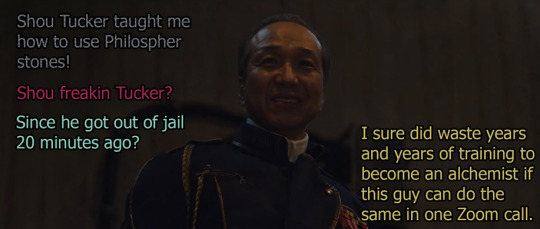
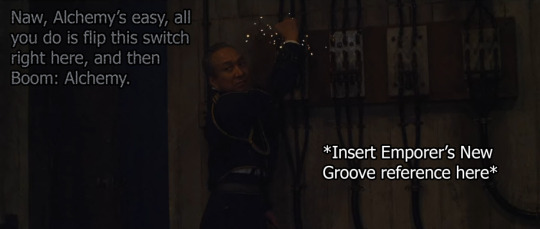
Yo remember this part of the anime? Where the bodies drop from the ceiling and it’s a hunk out of the final arc--it’s here. In this movie. This movie that can’t possibly afford to do that. Lets get some CGI animated bodies in here ASAP.
(see some texture regrets under the cut)
It’s like a Monet, as the Mean Girls say, because far away and shrinked to 500 pixels this looks kinda neat. They sort of look more like those slime ball that grow in the back of your throat rather than human bodies, but they still look pretty gross hanging up there.
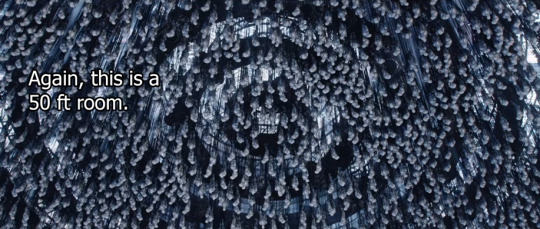
But then.....we zoom in. Remember again that this was full screen on my computer, and at one point was on a freakin movie screen. This level of 3d...was on a movie theater screen.
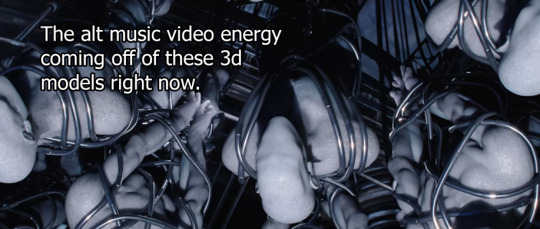
The mind boggles. The mind boggles!
Like as you know, I am an artist, and I’ve dabbled in...basically everything in my pursuit to make a dollar...and I have taken about 2 years of classes in 3D art with Maya and all those. I’m not thaaat great at it--I’m much more an illustrator/painter--but I feel like I have that reference point. Can I just say--the model is...fine...you can do a lot with layers of bump maps so you don’t need a truly detailed model (not like they did that, because they didn’t do that, but I can figure that maybe they had an intention to do that and forgot?)
But, there’s no connection of the wires to bodies. They just kinda float? The bodies are also all the same shiny-ness? To the point that it looks like a copy paste? (I don’t think it is, the wires are slightly different on a few of them) There’s just not much in the way of a texture map or a bump map. It just...there’s also something missing from the skin.
Skin is actually kind of rough to render, so when I did it back in the day, I followed like a checklist to make sure I had all the layers and steps to make someone look...clammy. Some things are kinda translucent, they reflect light a different way...especially white skin like this wouldn’t be just...white like putty. Dunno if you ever saw a white person, but we got so many veins...there was so much potential to make something really gross and fleshy.
Instead we got silly putty. It’s fine. I’m fine.
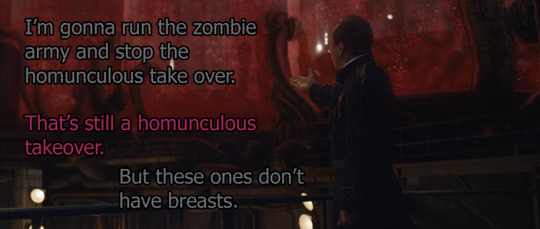
So General Hakuro decides to just...kill everyone right now.
This makes no sense to me.
That means that the whole thing of Lust killing Hughes was completely unrelated to General Hakuro. All Hakuro needed was Shou Tucker, who has been in prison for...I assume months since Ed shipped him off. And Shou was only released today? Just now? Just now when Hughes was shot?
So this all just happened at the same time by accident?
I mean the General sent us to the wrong lab initially, so he didn’t actually want us to be here, and now that we are here, he’s going to set off an entire army as a reaction to three people walking in and going “oops”?
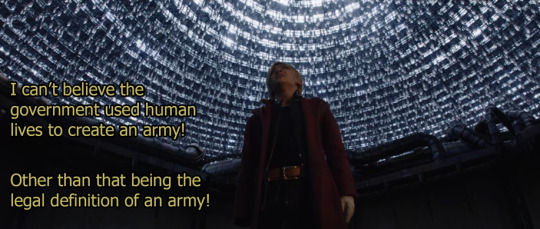
So, lets get a look at our army.
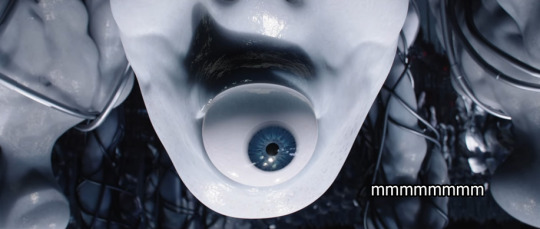
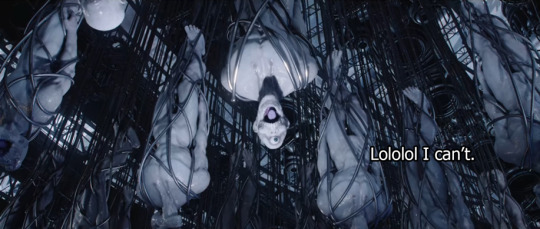
Oh it was so disappointing, this reveal. Not just the eyeball that has a bounce light coming from below the top lip there (how did that even happen???) but also when it opened it’s mouth, it had a flat animation of skin breaking--it wasn’t actually rendered 3d skin, it was like a jpg wrapped around it or something (or at least that was the illusion I got. That is fine for a video game or a TV show, but this is a movie. This is shot so that it can be displayed in a size bigger than your own house.
What happened to the animation team on this one? Not saying I can do better, cuz no, I can’t, that 3d chapter in my life was a while back, but I’m just one guy. This was an entire animation studio and they just...didn’t render 3d face ripping (which is their entire job, to work in 3d) and then they kinda just turned on the stock physics dynamics and dropped em instead of animating them.
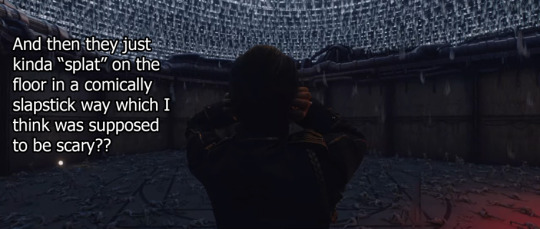
The way they fell was like fish from a bucket--the same amount of speed, too. they all ragdolled like a 3D shooter, their rigs just hanging on for dear life (and yes, you could see the deforming happen on the joints of these models.) I’m fine with having a computer program render something out with a physics engine...but there is a balance.
You do have to still go in there and finangle it back because...real life is hella stupid. Real physics? So stupid. It was hilarious how nonthreatening it was, too because they’re like...the size of shrimps in that zoom out image. The scale is just so wild!
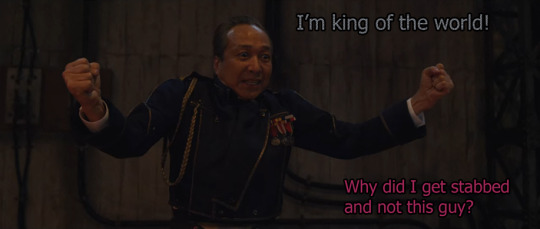
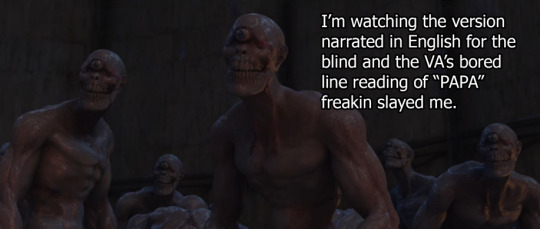
It was like one bored guy in a sound booth and they multiplied his voice three times. Golden. Absolutely golden.
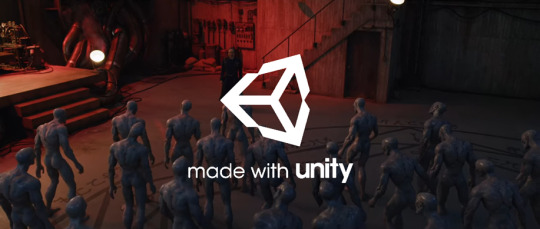
So these guys stride over, all of them with the same amount of speed (leading me to think it was probably a recorded walk cycle they all share with slight alterations between all of em) and they kinda just...pile on eachother in a weird way.
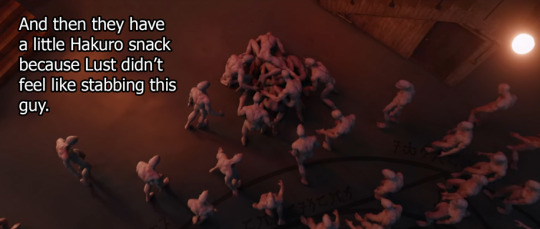
I will give them this: I was happy to see something that wasn’t physics or procedural. They mo-capped and animated that part for sure. It had the touch of an artist’s hand. It was also a very funny way for Hakuro to die because this guy was on screen for like 5 minutes, and maybe 7 minutes of this whole movie.
Youknow...I think it really says a lot about your nude 3d models if they’re not disturbingly human enough to trigger the tumblr filter, youknow?
Anyway, Envy looks on.
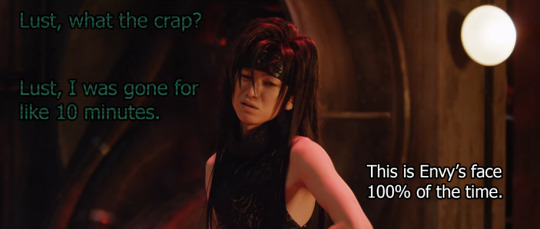
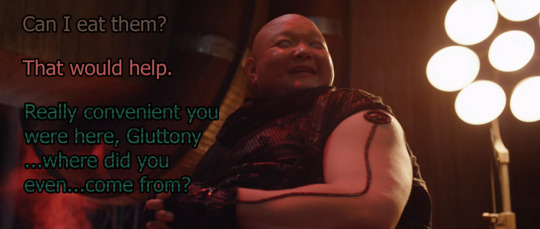
And then Gluttony saves the city.
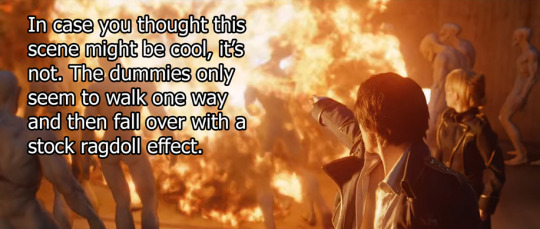
Meanwhile, they decide to bust out the fire effects and Mustang becomes the most useful person in this entire movie. Like honestly this movie was poorly named, because it should have just been “Mustang saves the FullMetal Alchemist’s Entire Ass.”
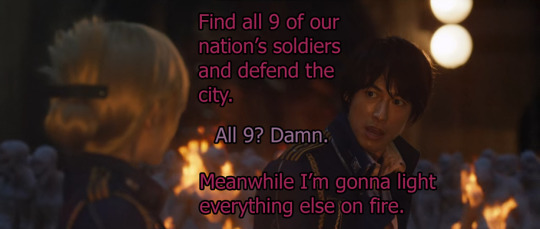
The next part seems like I forgot a cap, or maybe missed something. I swear to you, I did not.
First off, Al becomes fullmetal and makes this happen without an alchemy circle. The show doesn’t really care to talk about that though, it’s just a thing he can do now, and you’d only notice it if you were writing a Tumblr post about it.
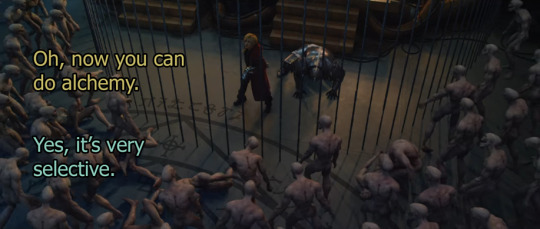
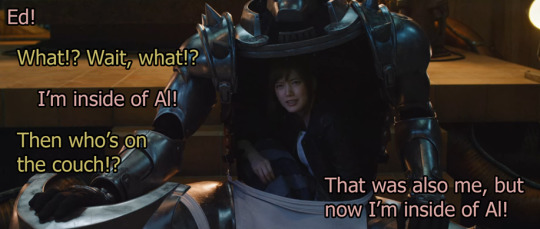
I swear to you, Winry is just inside of Al and there is no explanation.
There is no explanation for this.
She was on the couch...why is she not on the couch? What?
And then when you think they might have a moment, Ed’s like.
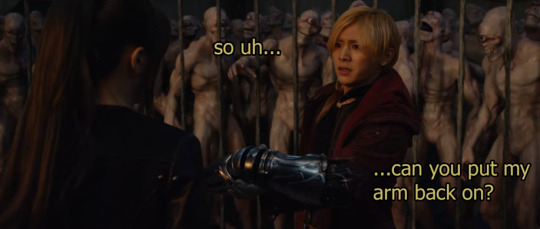
Damn.
For reals what the hell was that entire scene except for a way for Ed to get his arm stitched back on in like 2 minutes?
Outside, Envy and Lust are just strolling around the back-alley of this red brick building we have seen used for this entire movie.
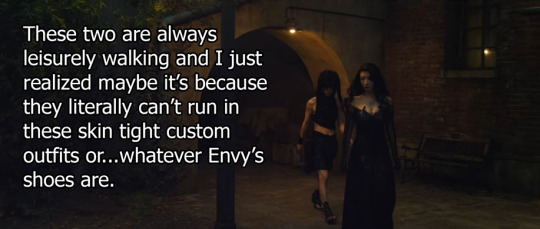
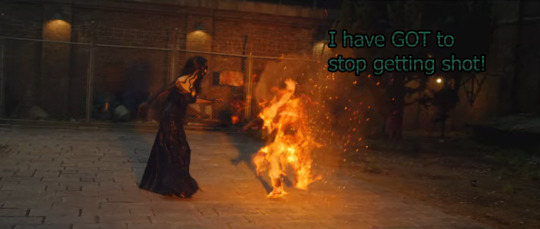
And like...it’s so funny to me because they weren’t trying to run or hide. It makes complete sense why they got shot. This is what happens when you just...walk away when the whole military guard wants to kill you.
Now lets go see how Hawkeye is faring.
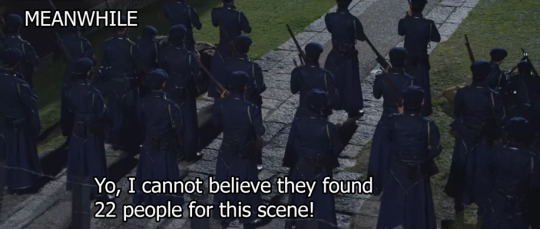
Luckily, all of the ambling bodies have decided to walk slowly through this one weird grass section between extremely long buildings.
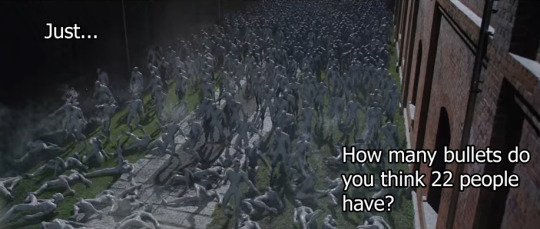
And Hawkeye tells everyone “You have to shoot their heads off” and I want you to look at that scene and tell me how many of those bodies still have heads.
Oh, all of them. Don’t worry about it.
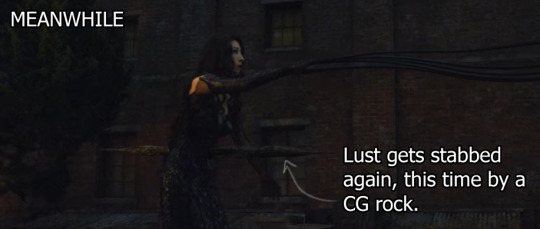
Kinda hard to see, but Ed shows up to give Mustang a hand, which was fully unnecessary but we’ll get to that in a bit.
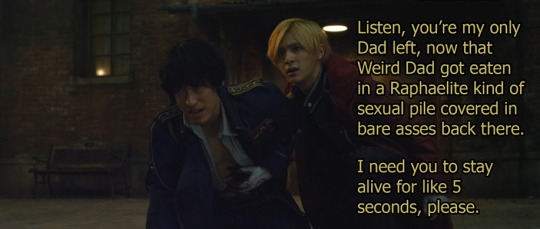
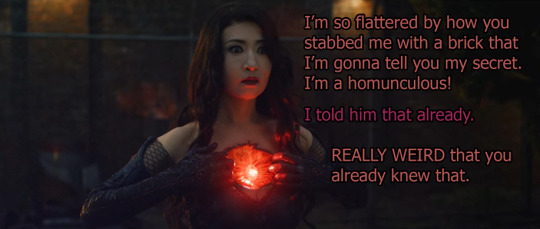
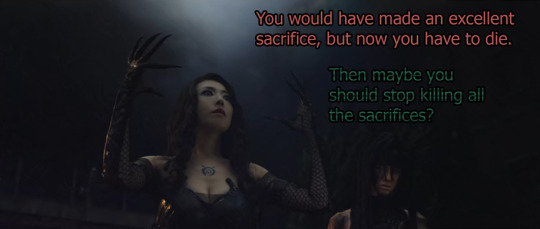
This movie is such a gem.
Ed goes big brain and realizes that Envy is still burned up, and thus is about to pass on.
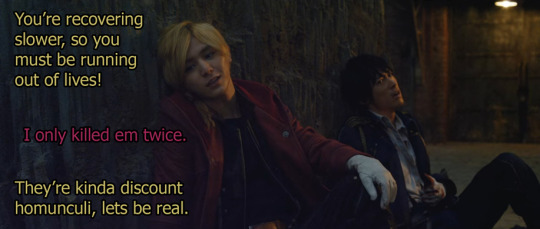
And whatever, I’ll take it. It’s not like the movie has told us that they are made out of 1000000 lives, for all we know, in the movie universe, they really are only 4 lives. Like half a cat. Maybe Father only killed half a cat instead of an entire city.
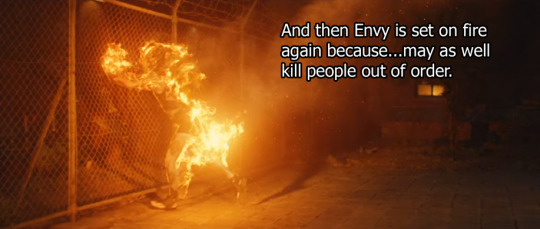
Yugi Muto would be so freakin proud of Envy for how often this guy gets hit square in the chest with fire balls. It’s basically every scene where Envy and Mustang share screen time.
And don’t worry, I don’t think Envy died? But they sure made it look like he did, which I’m sure everyone everywhere was really happy to see, since Envy’s death was one of the climaxes of the whole series. Like people used to make these lists of “top 10 saddest anime deaths” and how many people had Envy on there? Like everyone? People freakin love Envy and they did him so much dirty in this movie.
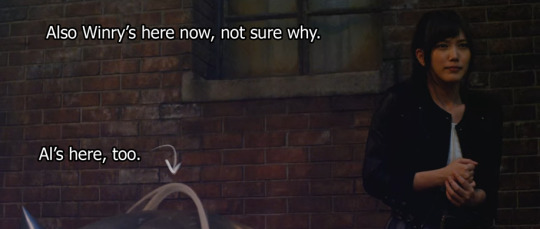
Again I have no explanation for Winry.
So Mustang is like, Ed, you make sure Winry doesn’t biff it in that corner, and I’ll do my actual job over here on this side. And yo, he did.
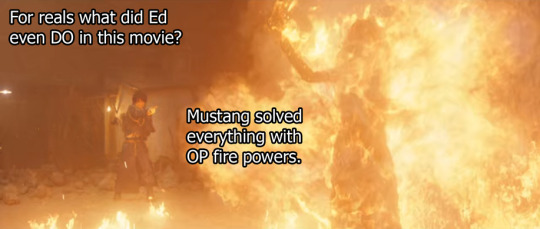
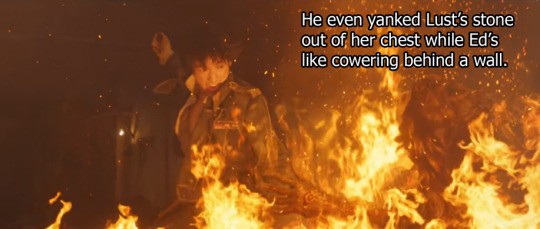
And so then that’s it, Lust is dead, and now we have a Sorcerer’s stone.
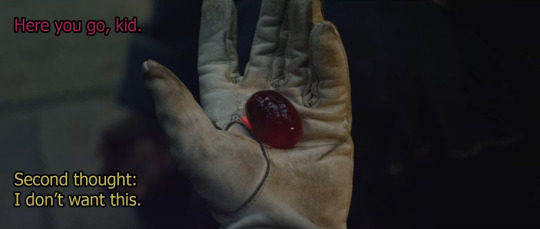
Man it looks delicious, right?
I’d eat the hell out of that.
Anyway, we only have one more update and we’re done with this movie!
I know!
I know! They only have 10-15 minutes to resolve pretty much everything, and that’s assuming that the credits don’t take up a heap of that. Hell, I might only have 3 caps next episode if that’s all credits. I honestly don’t remember.
Anyway, hope y’all take it easy this February, here is a link for people who just got here to read these FMA recaps in Chrono order.
https://steve0discusses.tumblr.com/tagged/fma/chrono
#FMA#Fullmetal Alchemist#Fullmetal Alchemist Movie#recap#photo recap#ed elric#colonel mustang#hawkeye#al elric#Winry Rockbell#so much fire#so much almost there CG
8 notes
·
View notes
Text
Ringling Animation: Is it Worth it?
This is not a post bashing Ringling College of Art and Design or its program. I just believe that after attending several semesters, I formed a new opinion that needs to be shared. It’s something that new applicants should consider just as much as any piece of portfolio advice they find. Several of you who come across this may recognize my name as the one who made that Ringling CA portfolio advice post. If that’s the case, nothing has changed regarding my opinions towards the portfolio process.
I’ve come to the conclusion that unless you know you have a passion for animating by actually trying it out before attending or applying, the Computer Animation major at Ringling is not for you.
I only have my experience to speak on, but I don’t want you to take this as me saying you shouldn’t try to apply or attend Ringling. This is purely me explaining how I came to certain conclusions through self-discovery.
I was naive; I grew up loving animated films and cartoons and believed my wish to be a part of that industry was reason enough to apply for animation. I had never used a 3D software like Maya before, but I assumed it would be one of those tools that just needed time and practice getting used to. (Arguably it still is, but more on that later.) I learned the hard way that the major is no joke; once sophomore year starts, the CA students only get busier and busier. I initially had the bravado, hearing from CA upperclassmen how tough it gets but believing I could handle it. I couldn’t handle it.
When it comes to the CA students, I feel like you could separate them into 3 distinct groups. Those who have never animated before, but quickly got the hang of it, those who have tried animating/studied animation at another school, and those who struggle but have a drive to push through. The common factor is that they either have a passion for animating or quickly gain a passion for animating. I steadily learned that I didn’t have that same kind of passion for animation. There’s only so far a person can improve with practice alone; only those with passion can soar, but no one can teach someone to be passionate about something.
I struggled with the Maya software throughout the entire semester and heavily considered switching majors. It wasn’t until a friend (who was also in CA) asked if I just didn’t like the workload when I knew 150% I needed to switch. Every major takes a number of different classes that are exclusive to each major. Story Development was a class exclusive to CA majors; it was essentially a storyboarding class. It was my favorite class, and while the assignments weren’t as time-consuming as the Computer Animation ones, I still had to put in many hours to work on the projects. The thing was, I was always eager to work on my Story Dev homework and didn’t mind (or didn’t notice) spending hours at a time storyboarding because it was always so much fun for me.
Realizing that I never felt that kind of excitement towards my animation projects (instead, I felt immense dread) made me wonder how many of my peers were in the same boat, but perhaps too afraid to say something. It also made me realize what I actually loved to do because I missed it so much. CA majors draw and have to know how to draw, but I wished there was more time dedicated to becoming a better character/environment designer. The fact is, no matter how good of an animator someone is, animation takes a lot of trial and error. It’s a very time-consuming endeavor, which is why I believe only those who really love animating should pursue this major.
The takeaway from all this is that if you’re someone considering applying to Ringling for animation, I advise you to at least dabble in the software yourself for a bit to get a feel for it. Take a class, try animating on your own, animate something in 2D or 3D. I would’ve saved a lot of time if I had known this before; I don’t want others to also later realize they’ve made a mistake. This isn’t to demean the quality of the program because I really believe they have the most amazing curriculum for those who want to work in animation.
Thanks for reading this.
#artcollege#ringling#ringling portfolio#ringling animation#ringling college#computeranimation#art portfolio#art help#arthelp#animation#animator
12 notes
·
View notes
Text
Jade’s SSO Rambles - 1 Intro
So I suppose I’ll make this a series? I’m gonna do some random posts about my thoughts and critique of Star Stable Online and this post is going to just be a kind of proper preface to that.
TL:DR Basically I do art and game dev irl and have thoughts I wanna share on the game without all the extra salt. I also mention my assumptions (not facts) on what the team is potentially dealing with.
Quick note though on who I am, I do consider myself a professional 3D artist and a bit more on the hobby side for independent (or indie) game development. I research a lot of game design and have worked on several smaller projects but I haven’t personally published anything other than game jam projects. If you’re really curious I do have a bachelors in media arts and animation but that has nothing to do with this, it’s more just to further point out I’m genuinely serious about my comments for improving the game and what I think they do well.
The other part of this preface is to admit some of my current (as of April 2020) assumptions and speculation regarding what the team is working with. I don’t personally know anyone who works there but I do pay attention to the community to some extent. I also don’t know for certain what they’ve faced in changes since the game’s release.
THESE ARE NOT FACTS, only my personal assumptions on what I suspect the Star Stable team is dealing with. I think it helps whoever reads this get an understanding of where I’m coming from in my thoughts. I’m probably wrong about a lot of this but I don’t expect confirmation. (Would love to hear it though!)
My Assumptions/Guesses (NOT FACTS):
The actual development team (devs, artists, writers and so on) is rather small, (under 20 people maybe?)
SSO was built using the original engine made for the previous CD games (Starshine Legacy and such) and was put together using assets from those games. (Basically it wasn’t made with say, Unity or Unreal but might be a new separate engine from those old games.)
The SSO engine is outdated (and possibly wasn’t made for multiplayer to begin with for all I know) and could be causing issues with implementing new features/game mechanics.
The team has a separate set of people working on only horses.
The art team switched from using 3DS Max to using Maya for their main 3D program. (There is mention of this in their posts/videos but I assume it hasn’t changed at this time.)
I’m uncertain if the team does much for play testing/quality assurance with their updates. Also hindsight is 20/20 so I’m going to have an easier time finding issues than they would while testing regardless.
I have more but those are some of the main ones that cover where I’m coming from and will flesh out my perspective right now unless things are clarified.
9 notes
·
View notes
Note
Hey, I‘m wanted to do animation for a long time but am worried about the cost of schooling/the chances of being accepted into a program. Do you have any advice?
hey! so this is a hefty question but i’ll try and keep it simple and short-ish
so 1. you don’t have to go to school for art or animation to get a job in art or animation
no one really cares where you go or if you go to college at all. We dont look at degrees or where you graduated from - only your skill and if you can do the job. We have people in our office who are self-taught in Maya or 3D Studio Max or Photoshop or Storyboard Pro. We just look at what you’re capable of doing, where your skillset is now, and if you’d be suitable for the specific project you’d be hired for
BUT!! you must have massive amounts of self-discipline if you decide to go this route. You basically have to act like your own teacher. Set deadlines for yourself, keep on a schedule, practice all the time, practice different things! Take a live drawing/anatomy class. Learn the basics (really learn them i can’t stress this enough. you can only stylize and deviate well if you know your basic rules of anatomy and animation, first)
2. even if you do decide to go to school, you don’t have to go to an expensive private college or university. Just go somewhere with digital design classes because that’s where everything is. You can take online classes, too!
3. chances are, they’ll accept you because they want your money. And I’m not saying this to say they’ll accept just about anyone... but they’ll accept just about anyone. some private art universities and colleges have been known to accept literally anyone because they want the tutiion money REGARDLESS of if their art is actually up to where it should be when they begin classes. By the time i graduated (yes, i did go to art school and i’ll get into why in my next point) a lot of my peers had dropped out or left school for various reasons. it was fucking difficult to an almost abusive level of stress and work so that’s....something else to keep in mind
4. i did go to art school which might seem like it contradicts everything i just said lol but let me elaborate. I grew up in a shitty small town with no job opportunities and just a few local universities with pretty barebones art programs that would realistically get me nowhere. I also didn’t have a lot of money growing up so i had no tablet and had never used photoshop before. traditional illustration and painting aren’t hireable skillsets for studio work, unfortunately. I knew that if i stayed there, then i’d be wasting my time and money and wouldn’t get a job in the field i wanted. so, i moved and went to an art university ONLY because i applied for every grant and scholarship i could. APPLY FOR THOSE SCHOLARSHIPS! EVERY SINGLE ONE! I came out with far far less debt than a lot of my peers because of my scholarships.
5. Ultimately, you’re gonna be competing with your art peers for the fininte animation jobs around. and its a shitty and competitive mindset that advocates working against each other rather than working with each other. tbh I hate twitter, but twitter is where all the artists and animators are and the amount of networking you can get out of it is almost mindboggling if you follow the right people
if you happen to have a portfolio and want to send it to me for a mini review so i can give you some personal help and direction, i’m happy to do so. I didn’t have anyone to lean on when i was figuring this stuff out and i really wish i did...so i try and be that person now. i’m not gonna hoard knowledge from anyone
hopefully some of this helps! thanks for asking and good luck!
17 notes
·
View notes
Text
A new blog
Hi there!
This is an SCP Blog for a game that I’m going to be working on mostly by myself. Facility Zero (or Site Zero) is a project for me to learn how to make stuff in Unreal Engine, but I figure others might be interested in this SCP Universe AU. This post is quite long, so I’ll put a lot of other information under the cut.
TLDR: I’m making a game based on an AU for the SCP Universe. It’s a side project that I don’t intend to make money on unless people buy from the redbubble collection I made or donate to me directly. I’m not a game developer, so there’s no real structure for getting it going right now. I’ll be posting some original SCP ideas here as well as updated/AU versions of some classical ones. Direct links to the original works will be provided.
So, without further ado, here’s the first post! Here are a few answers to some potential questions:
What is this au?
There was an end of the world even that happend in the late 1980′s. SCP-001 reacted, effectively stopping the end of the world. The consequence? Three members of the original foundation managed to retain all knowledge of the Foundation, but all of the SCP objects were lost. They spent the next few years rebuilding the Foundation. Some of the former SCP objects they have been able to find, while others have taken on new identities. There are some new ones too (ones that I’ve come up with on my own).
How many people are working on this?
Just me (lilpuppyzizi) so far. I don’t know if I’ll bring others in.
What programs are you using?
Maya, Substance Painter, Photoshop, Paint Tool SAI, and Unreal Engine are the primary products.
Can I help?
If you would spread the word about this blog, that would really help me stay motivated!
How much will this game cost when it’s done?
Nothing! :) This is a side project that I’m working on to learn Unreal. I don’t want to make money off of it, other than people buying art from my redbubble collection for the game. Or, if you want to just donate to me directly, send me a DM.
What do you have done so far?
Not much. I have the base idea for the universe, I have a few object ideas, and I have a logo for the new Foundation. I also have some railing done, a blueprint of the ground floor to the facility done, and a door object done. The door object is in Unreal right now, and opens when you hit E with a door sound effect. So uh. Yeah. Not much. I’ll be posting another update when I have something more significant, otherwise I’m just going to be posting the ideas for objects here for those who may want to read about it all.
If you’re so early in development, why make a blog?
I made a really neat logo. And I want a place that I can access easily to be able to have references to the stuff I write that isn’t google drive. I also want to get the word out that I’m doing something, so if people are interested can either ask me questions or like, follow it or something.
A few things to know:
I am not a game designer. I have a degree in 3D Animation. So I don’t know if I’ll have a development log right now. I have things that I want to get done.
I don’t know when I’ll have a demo available for people. Sorry!
As of making this post, I am unemployed. Because of that, I have time to work on this. But, if I get a job in my field, updates might slow down here on the game development side. I might still write lore stuff and post it here, but as of right now I don’t know.
2 notes
·
View notes
Note
Do you have any tips for people who want to study animation and be an animator?
hi, nonnie!
so it’s not really a secret that i’m an animation student, but i also want to put a disclaimer that this is my first year in college, and also my first time really learning to animate.
for more information before i jump into it: i study an art & technology degree with a pathway in animation (with some game knowledge) at a public university. i will also say that animation at my program, because it is different from a private art school, i’m not technically in the animation pathway — it’s something that you learn foundations for the first three semesters, and apply to get into your desired pathway (animation or games) to focus.
i have learned a LOT since i started school, though, so… let’s go!
art school is not the only optioni thought i was going to go to art school, but i really couldn’t afford it without taking out a loan and putting myself in debt. please, please keep in mind that there are other options to learn animation - many public universities have related/similar programs, and i honestly wouldn’t go to art school if i couldn’t afford it. do your research.
there are going to be people who are better/know more than you. when i started off the year, i knew nothing about 3d animation or any part of the 3d animation pipeline. i’d never touched maya before, or any of the programs in my school lab. like me, there were kids who’d never done anything like this before (about ½ the class), and there were kids who’d been modelling and animating for years. there are kids who did animation programs in high school, or who had opportunities like having animation mentors. my school district did not.you’re going to feel behind. you’re going to look at these people with really cool projects, and who already know how to animate, and who do lots of crazy cool things. and you’re going to meet people whose relative is working in the animation industry. regardless of your skill level, there’s going to be someone who seems to be ahead of you. that’s okay. you’re learning.
don’t commit right away (to one job/focus).this is a big one. when you go in to study animation for the first time, there are going to be a TON of different positions and interests. don’t focus on one thing and lose yourself in it. try everything. try modelling, texturing, rigging, animation, lighting and compositing. there are people i know who are already like “i want to be a character animator at blizzard” and that’s cool, and totally possible, but don’t limit yourself! you might have a knack for environment design, or maybe, like one of my professors you really want to be a lighter but after you get hired, your supervisor goes “you suck at lighting… but hey, you’re really good at grooming do hair and fur instead.” don’t do that! there’s also a growing demand for generalists, which is something i think i might be interested in myself. being a cg generalist means you focus in one thing (ie lighting) but you have knowledge of other parts of animation as well. that means that when companies hire you, you might light a model, but then maybe they’re short a texturer, and then you can pop up and go “HEY i can texture!”
use your resources. please. once you get into college, oftentimes your school has stuff for you. that’s included in your tuition. use it! for me, there are whole courses on lynda and the linkedin e-learning thing. youtube. vimeo. books. find things that are available to you and squeeze every last drop out of it.
get involved. this is the biggest takeaway from being in animation. you could be a great animator, you could be technically really, really good. but nothing matters if you don’t put yourself out there. look up local animation events. i recently went to one, and i spent an entire day listening to industry professionals such as mark simon, the storyboard artist for the walking dead. talk to people! ask them questions! i actually connected with an artist at airship syndicate who was at the event - she’s the daughter of an art teacher i went to studio with for years, and meeting her and talking to her was really nice. and i have her number. and if you have the chance to meet someone, talk to them. don’t be scared. this is your chance to get your foot in the door, or your chance to get advice from someone who’s actually made it. talk. to. them.
join student organizations. my school has an animation guild chapter, as well as a game developer club and some other related orgs. JOIN THEM. pay the $30 or whatever membership fee. the animation guild at my school has given me, out of all the things that i’ve done, the most opportunities during the school year. i went to an amazon prime screening of Undone. a dreamworks skype call. discounted tickets for that industry event i mentioned earlier. and there is so much more to come. it’s 100% worth it.
try to make friends! this is something that i kind of struggled with, but it’s really important.having friends is going to be your lifeline. every monday you accidentally sit next to a new person in the animation lecture? introduce yourself. when you and two other people are the only freshmen in the labs at 11pm? there is no better bonding experience. having friends means you can 1) pester them for help 2) suffer together 3) get excited about each other’s work. these people are going to be your future co-workers. some might be your future bosses. also make friends outside of your major. you need a break.
making animation =/= watching animation. this is a big, big, big thing. don’t go into animation if you don’t think you can handle it. what you see on the screen is NOT the same as the work that gets put into it. when you’re an animator sometimes you’ll put in over a hundred hours a week. when you’re an animator you have to keep up with industry changes; every year the programs and tech change, and every year there is something new and different that you need to keep up with or else you’re out. animation is not easy. it’s up to you to put in the work that will make you successful: spend time honing your craft and talking to people. you will cry a lot. you will work your ass off. you will fail all the time. but you have to keep going because you love it. and if you can’t do that, don’t be an animator.
eat. sleep. take care. being an art student is not an excuse to not sleep. it’s not. period. you’re going to have friends who “haha i slept at 5am.” it’s not a competition, there is nothing for you to prove. with the rigor and the difficulty of being in animation you need to take care of yourself. set yourself a schedule every day - set aside time for you to eat THREE meals and sleep for at least 6 hours. treat those like work time. if you take care of yourself, eventually you’re going to look around at your peers who are struggling and suffering and you are going to be better off than them. because you had a meal at lunchtime. because you got more than two hours of sleep. you’re going to learn better, work better, live better. don’t skimp out. it’s really easy to forget, so i will set alarms/reminders for myself. i typically go to bed around 11pm-1am every night, so i usually get around 7 hours on better days. i eat. just don’t be dumb, okay? you don’t want to graduate and just fall apart because you worked yourself too hard and you didn’t sleep for four years. take care.
i’m stopping this post here because it’s getting a little long but i still have so many experiences and thoughts i can share. so anon, if you’re reading this - feel free to come back and ask more questions!
7 notes
·
View notes
Note
are you realy in art school? how hard is it would you say?
i’m not in an art only school, but i am in an art program and take mostly art classes, so i think at least some of the things i say here will apply to art schools!
the difficulty mostly lies in how fast you can get assignments done. i know a lot of people who have difficulty getting work done just because they’re pretty slow at drawing and painting and things like that. generally the assignments in the early years aren’t too difficult because they sometimes work under the assumption that you don’t have much art experience and thus try to help you get better at art. later years often ask for you to do a lot more technically difficult art in a relatively short time frame.
if you’re in an animation or game design major like i am, you’re also definitely going to be taking classes on 3D modeling and rigging 3D bodies. those are probably the hardest classes for me, just because i’m not very good at like, understanding the software and figuring out how everything works. if you want to go into these majors, i’d suggest looking into getting maya, or at least the cracked version lmao. look online and look up tutorials on how to 3D model because trust me it helps so much to already have some basic knowledge about those programs.
if you have a good porfolio though (if you want to know what i did for mine feel free to ask!), it’s pretty easy to get in! but just know that a lot of art schools have ridiculously high tuition, so if you want to get into an art program but you don’t want to spend an arm and a leg, check out your local community college and see what programs they offer! they often offer at least some art programs, and you can ask what schools your credits can transfer over to if you still want to go to a traditional art college after you get an associates degree!
#anon#answered#i hope this helps! this is just what i’ve noticed and what i’ve struggled in#also don’t go to a quarter system college unless you know you can do a lot of work in a short period of time lol
4 notes
·
View notes
Text
literally me just complaining
I am very genuinely hurt by the treatment my school gave me in the three years I was there. This is my gentle full on vent. This is me getting out my incredible pain in a timeline.
When I went to NCC, my mental health was literally improving in strides. Two years and I walked out confident, happy, assured of my own worth. It was such a great school. I had such great friends! I was losing weight, I was running 5ks every day in the summertime, I was learning to love myself.
And then I started at Moore. My first year, my first day, my first class, I walk in at 8:30AM ready to fucking learn. I have my notebook, my flash drive, and my confident spirit. Here I was. I was at this fantastic school. All my professors at NCC were so proud of me for getting there. I was in a class studying my absolute favorite topic of my major: Character Design.
My professor walks in, six months younger than me and with a chip on her shoulder. She tells us that if we’re not pulling all nighters every project, we’re failures. She tells us we have an assignment worth 20% of our grade due the next Friday. A 4-person set of silhouettes from a fairy tale that make each character clearly defined as their characters. She gives us a rubric and only explains 80% of it. I ask about the other 20% and she responds “Oh I’m not grading on that, don’t worry.”
Anxious about this huge chunk of my grade, I skip out on a free music festival with my NCC friends and spend every night until midnight working on this project. I go through dozens of iterations of silhouettes for my characters. And then, I turn it in, and I barely pass. Because she gave me a 1/5 in the section of the rubric I asked her about. I ask her why? “These are too identifiable. They’re too obviously what they are.”
She continues this to the point where the rest of my semester is a fucking blur. I was miserable, having mental breakdowns once a week, and this lasted for about two months before I dropped the class because I was literally on the verge of killing myself.
She puts down every aspect of my personality, my very being. I worked in cut paper when I was at NCC and I did really well at it. I tell her I like working with shapes and it was my specialty at my previous school, she tells me “It doesn’t look like it.” I tell her my favorite games are Persona 3 (this is before 5 comes out) and We Know the Devil. She says the artist behind WKTD is a bad person and no one should play it, and that Persona is bad because why would any adult want to play as a teenager. She catches me listening to Love Live music and makes fun of my taste. When I had thought too hard about my project (a chimera where she literally threw an entire in-depth illustration at us the night before it was due and required us to pay fare to the zoo or she’d take 50% off our grade, WHEN I HAD LITERALLY JUST RECEIVED MY FIRST PAYCHECK and had almost nothing), and had everything about this animal planned, she asks me: “What’s the Latin name?” It was not mentioned anywhere on the sheet, it wasn’t involved at all. She docked me 5% for not knowing Latin
I seek out help, first, from my head faculty. I tell him the things she tells us. He says “oh I’ll talk to her, but that’s just how she teaches.” She comes in the next class talking about how much he praised her and how great she’s doing. She’s even worse to me. I cry in the bathroom for half the class and the head of first year classes catches me and literally lets me cry on her despite the fact I am not in any of her classes and tells me to drop. So I do.
My classmates for the rest of the semester are miserable. Everyone except for me and 3 others in my program are literally miserable for the rest of the semester. She cost kids their scholarships. One of my friends is so bad that literally the mention of this professor’s name causes her to have a panic attack. I accidentally caused one and felt awful.
This professor is the start of my Xanax dependence. And she’s never disciplined.
In the same semester they start teaching 2D animation. Except by start I mean start and finish. We are expected to know everything about 2D animation in one semester. We are never offered another class.
My second semester, two of my classes are taught by a man who DOESN’T KNOW THE PROGRAM and is teaching it to himself as we go along. He smells of alcohol, and at the end of the semester he disappears during critiques. We have to teach ourselves everything, except, SURPRISE. One of the classes is 3D modeling, teaching us the foundations of Maya.
We never learn the foundations of Maya.
Third semester, first of junior year, we find out the school has lied to us from the getgo. After saying every student got 1k for their internships, we find out students get $500. And the other $500 goes right to the school if you paid by month like I did.
We also find out that everything we didn’t learn in our modeling class was super important. Our professor--THE HEAD OF OUR PROGRAM--gives up teaching us and kinda says to do whatever for our 3D Animation class. I ask him how to do several things specifically (2D animation on a 3D model being one of them). He does not know how. He does not bother to learn.
During that semester, my grandfather dies. I am told by my Admissions department job that if I miss more than one day of work for the funeral, I will be fired. I never got time to mourn. I still miss my grandfather. I cried about his death literally every day from October to May.
Second semester of Junior year is a blur because I am having so many panic attacks. I find an internship, but it’s outside of my typical field. That internship saves my life. And that’s barely exaggerating. I hadn’t felt happiness in a year when I started it and suddenly every day was... exciting again. I made friends, I had fun, I felt human.
First semester of Senior year is... rough. But not overly rough, mostly because I’m only taking two classes. And one of them is with one of the three (3) competent teachers I had teach me my studio classes. It’s great. I genuinely enjoy working despite thesis.
I had won a grant in the spring of my Junior year to travel abroad for two weeks at the beginning of September. My head of program swears he will present my game and get feedback. I return and he says there was no feedback. I ask my classmates--he never presented. I never got critique on my concept until three months into it because I thought everyone knew what I was doing.
Second semester of senior year was the worst four months of my life. I had never been so hurt, so ignored, and so honestly lost.
-My senior thesis class is taught by a woman who has no experience in any of the programs we are using. She has never animated in 2D or 3D. She has never programmed or designed a game before. She keeps asking for more work because she doesn’t understand that the 12 hours a week I’m putting in in coding is seriously beginning to harm my health.
-The same professor teaches the modern culture of Animation/Game Arts class. She refuses to touch on queer subjects. Repeatedly. She drops the hbomberguy stream but knows nothing about it. I wind up being the one who had to explain what it was about.
-She requires us to take a trip to New York and doesn’t get funding for us. This includes transportation there and back, subway fare, tickets to events, and meals. Had she mentioned it to ANYONE in administration, we would’ve gotten free meals. She did not. She left most of my class alone in New York City with literally no idea where to go and no instructions on how to get back. That trip cost me nearly $100 in the end. (I did get to see the original Taminella puppet at the Jim Henson exhibit at the Museum of Moving Image, and the costumes from Labyrinth, which was totally worth it and I broke down crying at it because like, Jim Henson means the world to me? I want to be like him. I just want to make the world a little brighter.)
-Oh did I mention we were never fully taught C#, and yet I was expected to code an entire game in it because for my thesis I wanted to combine 2D art and gameplay? Yup. She didn’t know that either.
-They refused to let us know anything about setup for Senior show until less than 2 weeks before hand. We had to pay for anything installed for the show and any decor. Every other major knew at least a month in advance. We had less than 14 days.
-I walked in on my one friend about to harm themself more than once. I found others saying they were on the verge of suicide. I comforted more people than I think I ever should have had to in those last 4 months. Whenever I asked for help, I was met with a door in my face.
DESPITE ALL OF THAT I have a deep love for my underclassmen. I genuinely want the fucking best for them. They’re in that hellhole and they deserve better, and I want to be as much help to them as possible. Our major has no connections in the paid art world.
Last March, due to my work in the library (AGAIN THAT INTERNSHIP SAVED MY LIFE ), I was offered a job teaching game design to kids in an underserved area. It’s good pay and great work and great people. So when they said “We need more people,” I immediately said “Let me get in contact with my school.”
The head of the program and his full time faculty both REFUSED to either answer emails or meet with me and my job leads. It’s good fucking work. I love every second of it. I’m happy doing it. And I know I have classmates who would be happy too.
And they’re refusing to meet with me.
Everyone else I came in contact with at the school was happy to see me again. The deans were happy, my old bosses were happy, my career center was happy, my old classmates were happy!
But it stings to be rejected like that after busting my ass for three years to do my best.
I just... I feel like I’m never enough for anybody. And the damage they did to my mental (and physical) health is irreversible. I got addicted to anxiety medications, I’m struggling to be confident in myself, I literally get told almost daily at work to not do the things the program drove into me.
I’m getting better and learning to be okay again, but... I’m really fucked up by this school. And I don’t know what to do.
(Oh and the school counselor apparently didn’t actually have a license to practice and often told me my anxiety was in my own head and that it was my own fault bad things were happening to me. Like deaths in the family. And the way my teachers treated me.)
#cw: Suicidal ideation#i am okay#this is talking about years ago#if you're a student at my old school currently#heed my warning
1 note
·
View note
Text
12 Video Game Development Tools to Get You Started Making Video Games

Gaming is not just a game for the ones who enjoy it as most of the game players are 35 years old. Those days are gone when games used to be simple to play because nowadays virtual reality (VR), Augmented reality (AR), and mixed reality (MR) are involved as a new trend in the gaming industry. That’s why we are here to provide you the best engine and tools of 2020 for video game development that will make your game playing experience more fun and exciting.As we know, for game developers and especially for beginners, it’s never been easier for them to make gaming tools without the help of programming languages. But these days there are so many video game development tools online by which you can create games quickly and easily.
Best Video Game Development Tools Of 2020 for Beginners
Looking for new and exciting tools for video game development? Here are some of them that will help you to make video games!1 GDevelopThis tool is open-source free software and has an easy to use and intuitive interface. This tool allows the developers to create 2D games without coding or having any programming skills. But you need in-depth tutorials to know about all the aspects.Price: It has no charges or fees of any kind and it also provides free source-code. 2 StencylIt is one of the best video game development tools for beginners to create addictive 2D games without any code. It will help streamline your workflow and enhance development.Price:- It is free for web publishing (for beginners).- $99 per annum for desktop and web publishing (for Indie developers).- $199 per annum for web, desktop, IOS, and Android publishing (for studios).3 AutodeskIn this, you can write or download the script by using MEL language for video game development. It has a powerful and realistic rendering with ease of use. With a suite of programs, you can create realistic 3D models in it.Price:- It has a free version and $30 per month for Maya LT.- Starting $125 per month for Maya and 3DS Max.4 Construct 2It is easy to learn and permits you to create impressive video games in less time. Through this, you can easily make 2D HTML5 games without coding. But if you will take a free version of it, you will have only limited features.Price:- $499.99 for Business License- $199.99 for personal License - $299.99 for Business upgrade5 UnityIt is one of the leading apps for video game development that has augmented and virtual reality both. It is easier and more economical than any other game development tool and supports fully cross-platform development.Price:- Free, if funding and revenue don’t overdo $10,000 per annum.- $25 per month for a plus subscription that is for hobbyists.- $125 per month for a pro subscription for professionals and studios.6 TwineTwine allows you to make highly interactive and non-linear text-based programs as it is an open-source program. It just needs a little bit of programming knowledge.Price: It is all free because it is open-source software.7 GameSaladThis intuitive interface can be used easily and needs no coding knowledge for creating 2D games. It has a one-click feature and simple drag & drops function too to speed up the video game development.Price:- It has a free trial version and subscription package too.- Starting subscription has a $17 per month fee.- $25 monthly for the pro subscription- 50% discount for students and educators.8 RPG MakerIt is the best version out of all video game development tools as it has expanded the database including classes, characters, animations, actions, and more.Price: RPG maker has ranged from $25 to $80. It also has a free trial for 30 days for new users. 9 GameMaker Studio2It is very easy to learn as it has various resources and assets. It allows you to create 2D games of high quality and has a wide-ranging built-in library.Price:- It has a free 30-day trial and you can purchase its creator license at $39 for 13 months to publish on Mac and Windows.- You can also publish on Mac ubuntu, Amazon Fire, Windows, Android, and IOS at just $99.10 GameFrootIt helps the beginners to simplify the game development with interactive items to choose from a big database.Price: It is a free video game development tool but if you want a wide variety of images, sounds, and other elements, you can buy them.#11 Adventure Game StudioYou can create adventure video games like Full throttle and Monkey Island. It requires no coding language but in this, you can only make video games for windows.Price: It is free for all the users and has no limitations on any of its features.#12 ClickTeam Fusion 2.5This video game development tool is intended for advanced game developers but doesn’t need any complex coding. It has an event editor system, Box2d physics engine, and OUYA console for creating games quickly and easily.Price: Currently it doesn’t have any free version but the free version will also be available in a short time.
Conclusion
These all are the top video game development tools that are used by developers nowadays. All these tools require less knowledge of coding and can be considered as a great platform for developers, students, and learners. Read the full article
0 notes
Text
Q&A Intro to VR
A while ago, an old friend introduced me to some students doing a science project who asked me some questions about VR. They were kind of introductory questions, but I’m sure lots of people out there don’t know much about VR yet; so I decided to post my response.
“ Intro
Hey there future VR developers and creators!
My name is Alvin, and I've been working with VR and AR technology for about 5 years now. I recently graduated Fall of 2017 from UCLA with B.S. in Computer Science and a minor in Cognitive Science.
Just after graduating high school (wayyyy back in 2013), I remember getting the first Oculus Rift DK1 in the mail and setting it up. Even though it was a prototype, it was absolutely mind-blowing. I remember putting it on and being INSIDE Minecraft.
After that, I made it one of my goals to keep up-to-date with the industry and so while in college, I made a bunch of random VR and AR projects for hackathons. These include:
AR search - https://devpost.com/software/findar
VR walking - https://devpost.com/software/m-o-l-m
VR dodgeball - https://devpost.com/software/dodgelodge
These projects allowed me to learn a lot about how to make things for VR, and eventually landed me a research position at UCLA, under two psychology professors who studied human memory and human perception.
They wanted to study the human brain with the help of VR. So I built experiments using VR as a tool to put people into virtual worlds so that we can see how the brain reacts in certain conditions.
After two years of this, I was pretty set to go to graduate school, but those plans changed very quickly. A couple of my friends and I were getting odd jobs to develop VR projects for other people, and we were getting paid too!
So, instead of going to grad school, I and my team of friends started a company, called Escality (clever combination of ‘Escape Reality’), and now we make our own VR/AR games and also other applications for clients!
Here's the trailer for our first VR game on Steam!
Youtube: https://www.youtube.com/watch?v=PhzONE7-NQ0
Steam: https://store.steampowered.com/app/805320/Conjurors_Eye/
Okay enough about me, let's talk about VR!
Answers to Questions
How does VR work?
If you haven’t tried VR yet, you have to do that first. Find any way you can. It will blow your mind. And it'll be a good first step to understanding how it all works.
This video comes close to capturing what VR is like: https://www.youtube.com/watch?v=jNjmmLLBGHs, but seriously you need to try it for yourself.
Alright, after that, let's dive in:
A lot of things come together to make VR work, but the main two are: Displays and Tracking
For displays, VR headsets are just screens (like your phone screen or your computer screen) with a bunch of fancy sensors.
But for these screens to make it feel like you're somewhere else, they have to show two images (one for each eye) that are slightly different. This is what's called a stereoscopic display (stereoscopic, meaning two views).
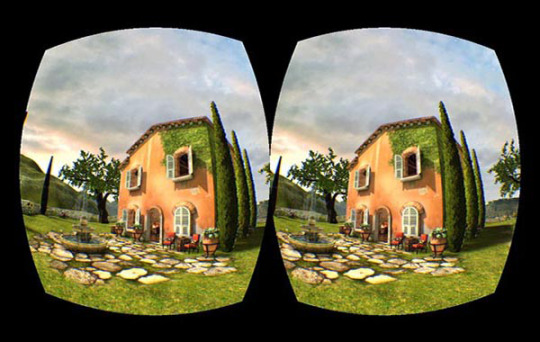
For tracking, well, it depends on the headset. But there's two main types of VR tracking technology: lighthouse (or outside-in tracking) and inside-out tracking.
Here's a good illustration of the difference:
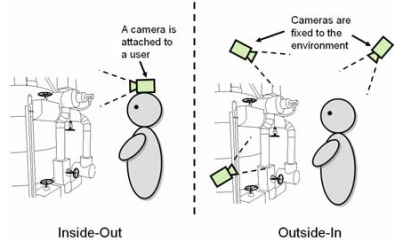
With inside-out tracking, the headset on the player has cameras and fancy sensors (like accelerometers, the kind of sensors used in phones to tell if they're upside down or not). The cameras and sensors work to understand the world around the player and make really good guesses to how the person is oriented.
With outside-in tracking, separate tracking cameras are placed around the room and look for certain markers on the player and/or headset to make a good guess as to where the person is and how they are oriented.
If you want to read more about this, here's a good article: https://www.wareable.com/vr/inside-out-vs-outside-in-vr-tracking-343
When you combine high quality stereoscopic displays with good and fast tracking, you can put that on someone's face, and they'll feel like they're somewhere else! That's VR!
How much money does it take to manufacture a VR headset?
The answer to this question is like the last one. It depends.
For example, let's take the Oculus Rift. It is currently being sold at $400, (released for $600). According to this article, it costs $206 for the parts, not including the labor put into putting it all together.
But if you look at other headsets, like the Pimax, it's being sold at $1000. There's no source for how much that one costs to make (probably a lot more).
How could you transfer VR files to space?
VR files are just regular computer files. If you've ever played a game on your computer, VR is the same thing! A VR game is just another computer game!
The main difference between VR and regular games is in the display (two images instead of one big one) and the tracking (using sensors and cameras to figure out where you're looking / how you're tilting your head).
How are VR movies made?
There are two types of VR environments: VR capture (taking the real world and putting it in VR) and completely virtual environments (building worlds from scratch in VR)VR capture techniques vary widely and usually involves taking a bunch of pictures of the world and mixing/matching them to form a sphere. Then based on where you're looking, you'll see a part of that sphere.
Here's a good article about how VR capture is done: https://www.viar360.com/blog/types-of-virtual-reality-capture-methods-that-allow-you-to-replicate-the-real-world/
For completely virtual environments, these are usually built in a game engine editor like Unity or Unreal Engine. 3D modeling is done to create virtual assets, then animation and VFX tools are used to make them move and look as if they're alive.
Popular 3D modelling software programs include: Blender, Maya, 3DS Max, and many more.
What supplies are needed to film a VR movie?
Assuming you're doing VR capture (taking the real world and putting it in VR), usually you'll need some kind of 360 degree camera. You can refer to the previous answer's link to that one article. Searching up each method for VR capture will give you an idea of what is needed for each technique.
Otherwise, if you're building completely virtual environments, all you need is a computer with a game engine downloaded (Unity and Unreal are the most popular and easiest to learn).
How much does the equipment cost to make a VR movie?
That highly depends on the technique used.
For simple 360 videos, all you would need is a 360 degree camera which costs anywhere between $100 to a couple thousand dollars depending on the quality of video that you want.
For more advanced techniques like photogrammetry and light-field capture, setups can run up to many thousands of dollars.
If you want to create completely virtual worlds, though, that's usually completely free! With software like Unity and Unreal, as well as Blender, you can create entire virtual worlds at zero cost. But it's a lot of work.
How are VR files stored or sent?
Again, VR files are just regular computer files. You can download a game from the internet, the same way you can download a VR game from the internet.
Will the VR video be clear even though they are heavily compressed?
Video files can be encoded at whatever quality you want them to be. They can be 1080p, or they can be 100000000 x 1000000000 resolution. That's up to you.
Whether or not your computer can run something that's 100000000 x 1000000000 is a separate issue (most regular computers today will have trouble even playing things at 4K).
Also VR headsets don't go that high.The HTC Vive Pro has a screen resolution of 2880 x 1600 (1400 x 1600 per eye).
The Oculus Rift has a screen resolution of 2160 x 1200.
The Pimax has a screen resolution of 2 * (3840 x 2160).
When you put a VR headset on, resolution isn't as important as refresh rate (the speed the screen updates per second). Research suggests that 90 Hz screens are optimal for VR use.
That means the screen has to update 90 times every second in order to feel good. Tracking also matters a lot, because with bad tracking, people can get nauseous and motion sick.
As for the video being clear, just make sure the resolution of the video matches the one that your headset supports. If you're using a HTC Vive Pro, make sure it's 2880 x 1600 (1400 x 1600 per eye), etc.
How do you incorporate sound into VR?
Most modern VR headsets have speakers for both the left and right ear. Spatial audio files exist that have data on how loud something is in your left ear vs. your right ear depending on where you're facing.
These types of files are called ambisonic audio files. Youtube supports First Order Ambisonics, and you can also read about this file type here: https://en.wikipedia.org/wiki/Ambisonic_data_exchange_formats#File_formats_and_metadata
VR games do this by default through the game engine code. So, when you play a game in VR made in Unity or Unreal for example, the sound will automatically be built-in and spatial, so that something on your left in VR will actually sound like it's on your left, etc.
Alright! That's all of the questions answered! Good luck on your project! Don't be afraid to ask some more! ”
0 notes
Text
Today when I was at the library they had a huge sign regarding a Fan Art contest. I thought OOOhhh I can do that! That would be awesome. And then I read their closed minded short sighted rules.
All media must be flat: Flat media includes, Paint, crayons, colored pencils, pastels, watercolor, collages, photographs must be WITHIN collages etc etc
At the bottom it stated Digital Media is accepted with the following rules. You MUST submit a sketch that is not done digitally and it MUST be created within using paint and drawing, meaning Digital Art CANNOT be 3D period, even if you print your image. Even if I fully created the models to make the digital image a 3D image art piece is NOT considered ART in their Fan Art Contest....This is utter bullshit.
I am not downplaying the importance of drawn art, I am not saying 3D art is better but it's BS that 3D art is not considered art in their contests. How is it any different? I may not create all the models I use, but I can damn sure bet you I paint on the skins, the clothing as well as paint afterwards on the finished render. How is my work any LESS work than anyone elses?
This has been an issue within the 3D community for YEARS I wrote about it on Deviantart back in 2012 read below if you’re interested
Despite the medium it's artby Angelic-Artwork, Apr 8, 2012, 12:22:39
Before I got into Poser, DAZ3D et al. I worked with several media and although I was never successful in the traditional sense it was something I enjoyed but was never really happy with the results. I as an artist of many facets also write some poetry, doodle, draw (pretty well if it's a still subject like from a photo, fruit etc) I created and still create digital scrap kits, clothing texture jpgs and several other items that would be useful in the creation of other digital media. I practice, albeit not as often as I should, creating my own 3d models, character morphs for existing models, clothing and prop textures, even if for my own use.
The point of this introduction is that I choose to work with the medium I choose to work with. This doesn't make my art any less art.Over the last 5 years or so while I have been practicing and attempting to better my 3D images through actual set up and render as well as postwork which sometimes consists of hours and hours of digital painting and image manipulation I have on several occasions had the unfortunate experience of running into folks not just online but out in the "real world" who like to spout on and on about how Poser and DazStudio image creation isn't "ART". These people like to call what I do a hobby, a waste of time. They like to tell me to "get a real job" when they have no idea how much work and effort I put into attempting to actually make something of my art and myself. I've read blog posts, Deviantart journals, newsletters and blatant slams that using a 3d rendering program to set up a scene, rendering it and the subsequent postwork is not only NOT art it's not even my OWN work.
A story I remember from a friend of mine that focuses on this thought idea always comes to mind. She entered one of her images in a local art contest and they called her to ask her to participate in a local showing with some of her images. When she was asked a few questions regarding her image and she mentioned that she bought models etc from several vendors she was quickly cut off and told well, umm we can't take your images now that you've told us. That's not really your art it's a composition of other people's work. Granted this might not be the exact story but the end result is the same. She basically is stating that although a painter doesn't make his own paint his end result is art, while this friend of mine's image was not even though she creates for sale in stores characters etc.In this modern era where computers are a part of everyone's daily life in America and many other countries digtial media is an integral part of our society. To stand by and claim that modeling in Maya, Modo and other programs that cost hundreds if not thousands of dollars is art but the hours sometimes days and weeks it takes me to personally bend and manipulate a model, create my own textures(ALL things which I taught myself with some help of some fellow "Dummies") so that my images have that one of a kind personal touch isn't art is like telling Ansel Adams he's some dude with a camera.
Art comes in many forms and media whether we want to believe it or not. The very definition of art expresses this idea. Wikipedia defines the word Art as" term that describes a diverse range of human activities and the products of those activities, but is most often understood to refer to painting, film,photography, sculpture, and other visual media. Music, theatre, dance, literature, and interactive media are included in a broader definition of art or the arts.[1]Until the 17th century, art referred to any skill or mastery and was not differentiated from crafts or sciences, but in modern usage the fine arts are distinguished from acquired skills in general."
The very definition of art would tell us that no matter what media you choose to work with, if you can create something and with a skill not every one has then it is art. I know from experience with talking to folks who have used DAZStudio, Poser, Anime Studio, and even Maya that not everyone can create in those programs. Those starting out don't consider their art real art. I know I never did. Not until I had been working with my programs for YEARS did I call what the result was art, but even the very first image you create is art. Hundreds of people every day open up programs look at them and say "Oh! HELL NAW!" close that bad boy back up and uninstall it without a second thought.
When I post my images at angelic-artwork.deviantart.com, Cloroflot and several other portfolio sites it isn't so some jaded crack pot of an artist can spend 30 mins of their day to be dismissive of the time, effort, thought, and creativity I put into my work. It isn't so family and friends can undermine my choices and what goal I want for my life.If you choose to work in paint, clay, modo, digital programs or fingerpaints what you create is art don't EVER let anyone tell you it isn't, and if you want to pursue a career in it. Do it! Keep working at it and don't give up. They don't call it a "Starving artist" for nothing, but while you're on that road to fame and fortune (cough cough) stop stomping all over the little guy who chooses a different medium than you do. It's not nice and it's certainly not the way to promote the need for The Arts in ANY country.My art is art even if I choose to use a computer to create it- Angelique Field aka AngelicArtwork.
1 note
·
View note
Text
How Digital Marketing Agencies Will Change Due to Covid - 19
Since the outbreak of the global pandemic COVID-19, many businesses are on a huge loss, but digital marketing agencies might, in fact, leap forward due to the novel Coronavirus. However, to leap forward, agencies need to concentrate on new planning, customer needs, and communication strategies. But, before that, if you own an agency, then you first need to know what impact will COVID-19 have and how things will change.
What Changes Will It Cause on Marketing Strategies
Due to the effect of COVID-19, at some level, the product market has also been altered for nearly every category and there have been clear changes in online demand and supply. As a consequence, digital marketing agencies should focus on their own product-market fit and also of their customers. This will be the most crucial exercise for the rest of 2020.
How Can You Win?
You need to concentrate on your customer and improve your strategies around their new challenges. For instance, there has been a drastic decrease in the searches "near me" terms while a surge in terms like "delivery". There has been a 15% increase in the traffic of YouTube whereas at the same time the advertising revenue has fallen down. Digital marketing agencies need to change their pricing, their services, and the way they take clients to the market.
What Changes Will It Cause in Organizations
Without any doubt, due to this pandemic, the way all the organization's functions will definitely change for a short period of time. Working remotely, the employees and the employers will get used to the current habit. In most cases, rent is not cheap and as a general rule, the profitability in the agency is low. Typically, agencies have between 5% to 30% of net profit and among that cost, rent plays a big part as the agencies usually love to have a good office which helps them to attract staff and surprise the customers. But, if the staff wants to work from home and the customers don't want to meet in the office, then it's a big advantage for the company. The best thing is that these savings or money can be invested more in employee success and client success.
But not having an office can lead to bigger problems such as the absence of team or company culture, lack of collaboration, community, and much more. It always feels good to work in an office together with your teammates. Without an office, the agency owners may face challenges related to management and will need to focus on accountability, and operations like:
● Regular show-up with team
● Per week responsibilities
● Time management with clients
How Can You Win?
This is the duty of every agency owner to decide, but, for the moment a few key things that might help an agency to function properly including video calls are;
● Non-work-related things or chatting with team members
● weekly multiple department check-ins.
What Changes Will It Cause in Communication?
Usually, clients love to interact with you or have an in-person meeting at their organization or at your organization. They love to enjoy a cup of hot coffee or have a quick snack break. But now, everything has completely disappeared. This puts up a necessity to everyone who attends those meetings just the same way they would do in person, but through a video call.
How Do You Need to Show Up for A Video Call?
Dress up nicely as you dress up regularly for your office, comb your hair properly, and make sure you are sitting in a bright and tidy room with a decent background that is presentable. Also, a nice set-up can definitely impress your clients.
Now imagine a scenario, where you are having a video call with one of your staff members who are in a sweatshirt, messed up hair, sitting in a dark room with their laundry falling apart on the floors. Now imagine a second scenario, where a second staff member is all dressed up nicely, with nicely combed hair, and has clear lighting on their face along with a whiteboard in the background with the company which can be used to note down the essential things. In the course of the meeting, you watch your digital marketing strategies are being mentioned and the same has been delivered to you. It is a completely new experience- the one that you've grown to believe in a professional environment.
More and more businesses are going digital and so will the marketing. It is important for marketers to think about the buyer persona and updated strategies. Digital marketing services need to respond effectively to employee needs, new customer strategies, and communication strategies, in order to thrive during this pandemic that has impacted everyone around the world.
OUR COURSES
digital marketing course in jaipur
advance java in jaipur
asp net mvc training in jaipur
asp net programming in jaipur
business component development course in jaipur
c programming course in jaipur
c course in jaipur
data structure training course in jaipur
hibernate framework course in jaipur
java script training course in jaipur
java web component developer in jaipur
spring framework training course in jaipur
sql certification training course in jaipur
struts framework course in jaipur
vb net programming in jaipur
visual basic training course in jaipur
advanced diploma in computer science programming adcs adcp in jaipur
certified ethical hacking training course in jaipur
cloud salesforce certification training course in jaipur
oracle certification training in jaipur
rkcl rscit course in jaipur
unity game development course in jaipur
basic excel course in jaipur
summer training 2020 in jaipur
excel vba training course in jaipur
microsoft excel advanced course in jaipur
ms access training courses in jaipur
ms office course in jaipur
ms project training course in jaipur
3d animation using blender course in jaipur
adobe flash animation training course in jaipur
adobe illustrator training course in jaipur
adobe indesign training course in jaipur
coreldraw training course in jaipur
dtp graphic design courses in jaipur
graphic designing diploma course in jaipur
maya animation training course in jaipur
photoshop training course in jaipur
ajax training course in jaipur
css training course in jaipur
html training course in jaipur
javascript training course in jaipur
web designing course in jaipur
angularjs training course in jaipur
cakephp training course in jaipur
mongodb training course in jaipur
node js training course in jaipur
php training course in jaipur
wordpress training course in jaipur
interview skills training in jaipur
personality development course in jaipur
spoken english course in jaipur
ai artificial intelligence training course in jaipur
big data hadoop certification training course in jaipur
iot internet of things training course in jaipur
machine learning course in jaipur
python class certification training in jaipur
r language programming course in jaipur
android app course in jaipur
ios development course in jaipur
cisco ccna certification course training in jaipur
cisco ccnp course in jaipur
aws cloud computing course in jaipur
cloud computing certification training in jaipur
cloud salesforce certification training course 2 in jaipur
mcse windows server microsoft certification in jaipur
red hat certified system administrator in jaipur
rhce red hat certification in jaipur
dst diploma in software testing in jaipur
hp loadrunner performance testing course in jaipur
hp qtp uft course in jaipur
hp software testing certification training class in jaipur
istqb certification exam course in jaipur
jmeter performance testing in jaipur
selenium certification training course in jaipur
arduino training course in jaipur
embedded systems training course in jaipur
pcb circuit designing course in jaipur
raspberry pi training course in jaipur
robotics and embedded systems course in jaipur
robotics training class in jaipur
vlsi training course internship in jaipur
matlab training course in jaipur
plc scada training course in jaipur
solar energy training course in jaipur
3d studio max training 2 in jaipur
advanced diploma in interior designing in jaipur
diploma course in interior designing in jaipur
interior design course training in jaipur
ansys training course in jaipur
autocad for mechanical training in jaipur
catia training in jaipur
cnc programming training in jaipur
creo pro e training course in jaipur
hvac training course in jaipur
nx cad training course in jaipur
primavera training course in jaipur
solidworks training course in jaipur
advanced diploma course in jewellery designing in jaipur
diploma in jewellery design courses in jaipur
jewellery designing training courses in jaipur
rhino 3d training course in jaipur
autocad for civil training in jaipur
civil 3d training course in jaipur
ms project training courses in jaipur
mxroad training course in jaipur
staad pro training course in jaipur
3d studio max training in jaipur
autocad training course in jaipur
google sketchup training in jaipur
revit architecture training course in jaipur
a hardware course in jaipur
n networking courses training in jaipur
tally financial accounting course in jaipur
advanced diploma in commercial accountant in jaipur
diploma in banking and finance in jaipur
gst goods and service tax course in jaipur
mis training course diploma in jaipur
sap fico certification course in jaipur
sap mm training course in jaipur
winter internship training for b tech mca in jaipur
acc certification training course in jaipur
ccc training course in jaipur
computer teacher training course cttc in jaipur
dca diploma in computer application in jaipur
doap diploma in office automation publishing in jaipur
doeacc nielit o level course in jaipur
pgdca course in jaipur
adobe certified associate exam in jaipur
apple certification in jaipur
autodesk certified testing center in jaipur
google certification in jaipur
mos microsoft certification exams in jaipur
rkcl authorized center govt computer institute in jaipur
tally certification in jaipur
0 notes
Text
I first discovered the process of animation when I was about 7 years old. My school gave my year group a lesson using a program called 2animate and at the end of the day, when everyone had left I was still in the classroom at the PC. I was just engrossed in the couple seconds worth of moving images that I had created and couldn't pull myself away from the screen. The teachers noticed this and my parents bought me a copy of the software which quickly started to consume all my time at home. Ever since then I've been fascinated by motion and the way things move and I was especially fond of animal run cycles. In recent years 3D animation has really caught my eye and more specifically photoreal CGI. Being convinced that something totally impossible was actually filmed and not just added with software in post truly fascinates me. In this video I'll be discussing lighting and compositing. These are a couple aspects of the VFX pipeline that I have only recently started to understand the importance of and some of the skills required to find a job in these areas of the industry. I also will use the techniques I learn about to try and create my own VFX composition.
The first job that I'd like to address is that of the VFX supervisor. One of the key roles of the VFX supervisor is to ensure that the filmmakers have an appropriate set up while recording the initial photography to save time and money or so that it won't require weeks of prep/paint afterwards in the rotoscoping or retouch departments before advancing further down the pipeline. What interests me most about this position though is the lighting reference they take care of. When filming a shot that will contain VFX a matte grey ball and a shiny chrome ball is commonly used. The grey ball is used to help the cgi artist understand the light direction, intensity, temperature and to gauge how harsh the shadows should be. To achieve this the artist would recreate the matte ball in cg and by comparing it with the image of the real one try to replicate the lighting conditions in the software with those that were present on set during filming. Once correct the light would then be applied to the model. The chrome ball however is used to understand how reflections are picked up on certain materials such as the shiny metal on a vehicle or something similar. It is also replicated in cg and is used to align what is known as an environment light or HDRI. This is basically a 360 degree photo that encompasses the 3D scene to give the models realistic reflection and lighting. The VFX supervisor decides where the balls should be placed and whether or not to move them during filming based on differences in light around the set. Some claim that it's old fashioned but from what I've seen many directors still prefer to use these quick and easy methods of lighting reference. A Macbeth chart usually accompanies the two spheres but this is used as reference for consistent colour correction rather than for lighting.
One of the best movies I can think of that shows brilliant use of lighting was the first Transformers movie. Scenes like this where you'll notice in the fog the light being blocked by Bumblebee, very cool stuff. Or how in this scene not only is the environment being reflected off Optimus but also Sam and Mikaela are reflected here. I couldn't find information on how they did this scene specifically but usually when you needa subject like people for example in a reflection they are usually filmed from the required angle or are actually modelled, textured and animated. This method can produce much better results if done well but is much more costly and time consuming. I also like how the animators matched the movement of Optimus's legs to move behind Sam exactly as he blocks the light. Little things like this are often planned by the vfx supervisors sometimes even at the time of filming to make things in post easier.
During my research I came across Erik Winquist, a VFX supervisor who I found particularly inspiring. He graduated Ringling College of Art and Design with a degree in computer animation and started his career in 1998 when he was hired as an assistant animator at Pacific Data Images. Fast forward a few years and he's working at Weta Digital and has been involved in the making of huge films such as The Lord of the Rings: The Two Towers, War for the Planet of the Apes, Peter Jackson's King Kong, Avatar and many more. He claims that every show is completely different from the last and as a result a lot of problem solving is required, especially when you have no idea how you're going to accomplish an end goal at the outset. Erik says he and his team are constantly jumping in and out of Maya and always have a Nuke session open for one thing or another. This brings me onto my next point, compositing.
Compositing in its simplest form is combining multiple assets that were created seperately into one scene to make it seem like it was all shot together. One of the challenges a compositor must deal with is the tracking of the clean plate. This is so that the digital camera within the animation software is moving around the model in a way that matches the tracker footage. There are a number of softwares that can be used to track a camera through 3D space, After Effects, SynthEyes and 3DEqualizer just to name a few. I'm going to focus primarily on Nuke though later in the video since it was mentioned by Erik Winquist and is easily accessible.
I was encouraged to try and utilise the knowledge and techniques that I've been researching and give 3D compositing a shot myself. If I take the necessary steps it should allow me to bridge the gap between 3d animation and the real world.
So first thing I did was take a simple video with as little shake or movement as I could manage so that Nuke would be able to track it easily. The software tracks specific points on the footage and uses the data to calculate a 3D space and the movements of a camera through this space.
This is a character I created who's supposed to be made from a material with similar properties to diamond or glass. I chose him to be my Guinea pig in this particular experiment because I thought his transparency would react with lights in interesting ways. Within Maya I created square lights above the model in the same formation as those within the room I filmed in to make the lighting as accurate as I could. Despite this you'll never really be able to perfectly replicate the lighting conditions without recreating the environment within Maya to simulate how the light actually bounces around the setting.
Unfortunately I wasn't able to capture a great quality environment light. HDRI stands for high dynamic range image and is basically an image that shows a greater range in luminance levels compared to a standard image by reducing the loss of detail in the highlights and shadows. This is often achieved by creating a blend of several images that were taken at different exposures. I only had my phone and an app I downloaded to help create the image so it didn't turn out great. Not that this matters much though since I'm just using this as an opportunity to learn more about VFX processes and on top of that I didn't know how to correctly apply the hdri image to the scene and I encountered quite a few render problems while trying to work around this. In the end I decided to just render out what I had and this is the result. Unfortunately as you can see the model doesn't look convincingly embedded with the image. I assume this is partly due to the absence of environment lighting or the lack of scratches and imperfections on the model that you would expect to see on a real object which would otherwise reflect light differently. I actually think biggest reason though is the noise levels of the plate versus that of the clean model. The contrast really ruins it for me. At the end of the day though I got to experiment with some new software and while I don't yet have access to all the necessary tools that are required to create the convincing VFX shots I'm after I still think it was a decent first attempt. I'm excited for next semester to learn more about compositing.
Now what to possibly do with all these newfound skills? While researching career paths I tried to stay away from the hugely successful, international companies like Weta Digital or ILM and look for smaller, more local and UK based companies. I came across a company called Milk which I'd never actually heard of but was suprised to discover that they're an award-winning independent vfx company based in London that have worked on TV shows and movies such as Doctor Who, The Martian and The Chronicles of Narnia to name a few. They are currently advertising a lot of available roles at the studio, one of which being compositors. Some of the qualifications they list to become a compositor include a good working knowledge of Nuke, a degree in related fields of film, communications and art, and ideally at least two years experience in feature films. Some interesting statistics about the industry include Closer to home still is the company...
I've often thought about how an independent career away from a studio might play out. There were several guest speakers who came in to talk to the animation department over the semester about possible roads to go down when searching a career. At the moment not many interested me but the one that stood out was James Beavers. He created a YouTube channel mainly focused on gaming with over 2.5 million subscribers. What's interesting though is he studied the animation course at Northumbria university as well and has gone on to create this really sucessful channel. Owning a popular YouTube channel has always been something I thought was pretty cool and it made me think of alternative career paths that I could go down. Another YouTube channel that I'm fond of is Corridor. They have actually taught me a considerable amount of what I know about VFX and they make videos like this, similar to what I could one day produce with the knowledge and skills I develop.
0 notes
Text
Youth Mixed Reality Development
October 9th, 2019 marks the official announcement of another program produced by Chronos Global Academy: CGA Youth Mixed Reality Development. This program is designed for ages 8 through 15, which is an age group Chronos did not serve before. Now we have an all-encompassing program that serves people as young as 8 years old, and which includes youth and adults, individuals and corporate groups. Since 2015 we have been offering introductory and advanced courses for VR/AR development. And now we have a new program, which is largely about 3D modeling.
What is 3D Modeling?
The evolution of a 3D model of a dinosaur by Chronos Instructor Drew Daleo
3D Modeling is the term we use for the creation of a virtual three-dimensional model of an object.
3D modeling is used in many different industries, including virtual reality, 3D printing, film production, video games, construction, architecture, aerospace, automobile, and others. Check out the bottom of this article for a list of useful web links.
3D modeling is an extremely useful skill that will never become obsolete. It’s what I call a universal skill, that is, a way of thinking and understanding the world that is independent of any human language. Like mathematics, computer programming, physics, or engineering.
If you learn a skill or subject that is not universal, let’s say law, or Greek literature, or even how to play baseball, then if you find yourself in another country, continent, or part of the world — that skill will not prove useful to you in terms of helping you with a career or a job. More importantly than moving to another country with a different culture, however, is the ability to contribute to a project or company that is based in another country. With the ability for people to work remotely (as in another continent) that we have today, learning universal skills is more important than ever because it’s not just about the possibility of moving to another country, but rather being a professional who could can work from where you are and provide value to any company or project that needs those universal skills.
A universal skill, however, such as mathematics or even being a surgeon — is something that makes you useful to practically any society no matter where you are in the world. It makes you more marketable and valuable as an individual and professional. 3D modeling is one of those skills.
The 3D model of a car on a 2D screen
What are students expected to learn in this program?
In this program students will learn the fundamentals of 3D modeling. As pointed out earlier, 3D modeling is a skill that is useful in a wide-variety of industries. There are literally hundreds of software applications for 3D modeling, and for a variety of specific uses and applications. In our case, we are teaching the basics and most important concepts. From there, students can choose the direction they want to go, and which industry they want to go into.
It’s the design of our Academy to produce talent for our own projects. Many people don’t know this, but our company has and does create educational content for Virtual and Augmented Reality. As we produce more advanced courses, we will be using 3D modeling for Virtual & Augmented Reality as well as 3D printing. These are two different areas but again, we are focusing on fundamentals. Students that want to go into VR or game development will naturally apply themselves and specialize in those fields. Students who care more about producing physical objects or manufacturing will naturally find themselves working more with a 3D printer.
And yes, it’s our goal to produce students that can do both competently. This will not happen overnight, but that’s the idea: we are investing in developing minds that are capable of and have the skills to do 3D modeling for more than one industry.
With so many software applications for 3D modeling available, which is the best and which one(s) will students be using?
Yes, there are quite a lot of useful 3D modeling applications available and being used. The original application we all hear about is Autodesk AutoCAD, which is used for engineering. That program is almost like designing free-hand, which means you can design almost anything with it. But the learning-curve for AutoCAD is very high, and AutoCAD was first released in 1989. A lot of other 3D programs have entered the market since then, and some are easier to use and/or address more specific needs.
For the VR apps we’ve produced, including VR Guest — we used Autodesk Maya which is considered industry-standard. Maya is a very powerful application, but it requires that each user pay Autodesk a license fee for using the software. That license fee is now monthly (Autodesk has done away with perpetual licenses), and Maya costs about $200 a month. We have also used other software such as Autodesk 3DS Max, Blender, and other others. When we were experimenting with architecture we used Inventor, 360 Fusion, SketupUp, Rhino, Revit, and probably others I can’t remember.
For this program we decided to start with Blender for the simple reason that Blender is free and open-source. This means that students can learn the necessary skills, and continue to make progress on their own by downloading Blender which is free to use, so they don’t have to worry about any licensing they would have to pay.
Now, some people will say “how can you teach Blender, which is not industry-standard, or as powerful as Maya?”
And I’d like to say something about that. First, Blender is on the way to becoming industry-standard. Blender is a very powerful suite that has benefited from an amazing team of developers that have done a great job making it what it is. Second, Blender has a bright future: the Blender foundation has received substantial funding/grants from significant players like Epic Games and Ubisoft. This will ensure that, with the winning development team and proper management that the Blender Foundation has enjoyed, that Blender becomes a formidable competitor in the 3D modeling industry, a force to be reckoned with for sure.
Moreover, I’d like to make a very important point: one might argue that an application like Maya is has an edge over blender, but to truly take advantage of such benefit you likely need to be a very large studio working with a very large budget and with a complex pipeline. If you are working on a movie that involves CGI and 3D modeling that is costing tens of millions of dollars, then I can see the argument of using Maya over Blender as valid. But this is not the case in what we are doing, and especially in the VR industry: VR apps are for the most part produced by small teams studios and teams of people, including indie developers. Indie developers in particular are not interested in paying thousands of dollars for the use of software to produce an app that they don’t know if it’s going to return the cost of development. As for VR, the user base right now is still very small, so the people who are doing the work are taking a risk (they are heroes in my book), and Blender will provide practically everything you need, from asset production to animation and a lot more. And keep in mind that Blender, while already quite powerful, continues to evolve and get better.
Lastly, keep in mind that what we are focusing on are the fundamental skills that one should know when doing 3D modeling. Such skills are independent of the software, which means you can quickly and more easily get up to speed with other software applications should you find a need to switch. And in the future we may teach Maya or some other application that has widespread use.
Who is going to be teaching this program and where?
The instructor for this program is an amazing individual and accomplished 3D model artist named Drew Daleo. You can check out his portfolio at www.drdaleo.com. Drew not only has vast knowledge of and experience with 3D modeling, but he has a passion for teaching as well. And he has 3 kids, which means he knows what he’s doing when it comes to teaching kids.
What other thoughts or ideas are worth mentioning?
There are a couple of important things worth mentioning. This program was not easy to produce. It’s our best program. It’s a program that is worth doing more than once. It’s a program with more applications and for more industries than just VR/AR, keeping in mind our expertise is with immersive technologies.
This is an amazing program that will continue to grow and evolve. It’s for this reason it’s called Youth Mixed Reality Development. It’s a program that is good for adults also, but we want to focus on kids. I believe in kids. We have not yet worked with kids younger than 14, and so at first I was somewhat apprehensive. This is one of the things that made the program somewhat challenging to produce. I did not want to make any mistakes, and I wanted to get it just right. The results is that this is in my opinion our best program yet. And I’m very excited about finally being able to work with and teach a younger generation.
“For our first Youth Mixed RealityDevelopment program ever, to be offered in November 2019, I want to offer each student a 3D printer that they can take home with them. No, I don’t mean a 3D print. I mean a brand new 3D printer that students can take home with them, that’s right. Sign up by October 25 to win one. We will have free and fun weekend sessions where we will set up these printers and print 3D models.”
Ricardo Parker, CEO & Founder of Chronos Global Academy
Second, I think that 3D modeling for other industries is very important. It’s important that we have a program that is not just VR. So we have worked to create a program that serves other industries as well; in this case 3D printing. This made the program harder to produce.
And as a final note, I’d like to thank the people who supported me and made this program finally possible and available. The list is long, but I will mention Seaton Gras, from SURF Incubator, James Porreta from Neighborhood Heros, Greg Bulmash from Seattle Coder Dojo, Adam and Andrew Powers from Keytech Labs, Emilion Morales from Renton City Retro, Oscar Baechler from Seabug (Seattle Blender User Group), James Wilson from Mountlake Terrace High School, Sean Siem, Anika Sinha, out friends at Logo Unlimited and many others (you know who you are).
This is a unique and creative program that does not focus on coding. Therefore it works well with all the coding schools and programs that already exist in our area.
Important links:
Blender: https://www.blender.org
3D Modeling https://whatis.techtarget.com/definition/3D-modeling
Book a VR/AR experience with Chronos: https://www.airbnb.com/experiences/278296
Guest post by Ricardo Parker, originally from https://medium.com/@ricardoparker/youth-mixed-reality-development-program-by-chronos-global-academy-9dcbc271f389
check out Ricardos site here: https://www.chronosga.com/
Youth Mixed Reality Development was originally published on transhumanity.net
#3D Printing#3dprinting#AR#Augmented Reality#education#MR#Virtual Reality#VR#crosspost#transhuman#transhumanitynet#transhumanism#transhumanist#thetranshumanity
0 notes